November 04, 2010
By Brian Fortenbaugh
By Brian Fortenbaugh
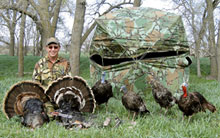
Advertisement
Dave Keiser employed a whole flock of stuffed decoys to lure these two last-day toms into bow range. |
Advertisement
If I were forced to pick only one animal to hunt for the rest of my life, it would be the wild turkey, hands down. For me, nothing compares to the sight of a tom strutting for his hens or to the booming sound of a gobbler breaking the silence of a spring morning and standing every hair on my body on end.
I've killed plenty of birds with my shotgun, but when it comes to taking one with the bow, I'm snakebit. Every turkey season I begin with bow in hand, high hopes, and "This is the year!" running through my head. But every year myriad frustrations force me to trade my bow for a gun.
Perhaps my run of bad luck could be changed with a little guidance from two guys with an unbelievable track record for taking turkeys with archery equipment.
"I want to bowhunt turkeys with you guys this spring," I told Double Bull owners Brooks Johnson and Keith Beam at the 2005 ATA Trade Show in Indianapolis, Indiana.
"Sure. We're going to South Dakota in April to hunt Merriam's with Dave Keiser. I'm sure he has room, and we'd love to have you along," Brooks said.
As soon as Brooks said the name Dave Keiser, I knew I was in for a treat. Dave's outfitting business, Double K Guide Service, based in Gregory, South Dakota, has a first-rate reputation. Dave leases several thousand acres on dozens of farms, and in 2004 he guided 44 bowhunters to an unfathomable 62 longbeards!
Primedia Outdoors' VP, Group Publisher Mike Carney and Bowhunter Magazine TV cameramen Bob Mussey and Sean Hagen would be joining me on the hunt. Hopefully we would fill our tags and get some great footage for TV.
APRIL CAME FAST, and soon I was on a plane bound for Sioux Falls, South Dakota, where I met up with Bob Mussey. It takes three hours to drive from Sioux Falls to Gregory, and for some reason I'd forgotten about South Dakota's reputation as a wingshooter's paradise until I spotted the first ringneck, then another, and then another. My German shorthair would die of a heart attack, I thought.
We met Mike and Sean at a bowling alley in Gregory. Brooks was out trying to fill the first of his two tags, which he did, and he, Keith, and Dave would hook up with us after dark. With time to kill, we grabbed a bite to eat and bowled a few games.
Camp was a short drive from the bowling alley, and after we'd settled in, Dave gave us the game plan for the next three days. We'd start out the following morning and set up on birds Dave and guides Tanner Feyereisen and Chris Mikkelson had roosted that evening. Dave, Tanner, and Chris would keep tabs on us from long distance. If nothing happened after the first hour, they would pick us up and we'd look for other birds to set up on. "We scout all the time, and we pattern birds well. If the initial setup doesn't pan out, we'll keep bouncing around until something works," Dave said.
Continued -- click on page link below.
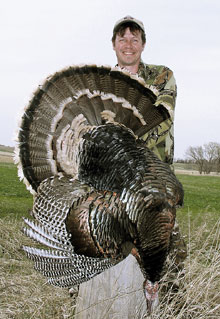
Double Bull co-owner Brooks Johnson backed up his turkey lessons with a Merriam longbeard. |
In South Dakota you can hunt turkeys all day, and Dave said the hens usually start leaving the gobblers in late morning to go to nest. Once his hens have left him, the tom gets a whole lot easier to hunt. "If I could convince my hunters to do it, I'd tell them to sleep in, because the best hunting doesn't start until after 10 a.m.," Dave said. Dave's confidence was contagious, and I was almost too excited to sleep that night.
Well before daylight the next morning Bob Mussey and I were loading our gear into Chris' truck when I noticed a stuffed hen decoy sitting in back. Chris told me the local taxidermist makes them for Dave, and the results have been incredible.
A short while later we pulled onto a dirt road that led to a pasture. Chris told me there were several gobblers and a bunch of hens roosted on the other side of the pasture about 80 yards from where he was going to set up our Double Bull Matrix blind. He said the birds usually work their way across the pasture shortly after fly down, but he couldn't guarantee they would come within bow range because of the hens.
Inside the blind, Bob set up his camera equipment while I prepped my friction calls and worked my favorite diaphragm in my mouth until it felt just right. When it was just light enough for me to see the decoy in front of the blind, a rooster pheasant cackled to my right. The last gravelly note had just left the cockbird's beak when three gobbles boomed from my left. The pheasant cackled again and the birds -- three of them -- fired right back. I made a few soft calls, and the birds responded almost in unison. Then the hens started clucking and tree yelping, working the gobblers into a frenzy. I heard the birds fly down, and then all was quiet.
One quiet hour later it became painfully clear what had happened: the gobblers flew down, got with their hens, and were now content to just strut around without saying a word. When Chris pulled up, he told us the birds had hit the ground and traveled in the opposite direction. He had an idea where they might be headed, so we jumped in the truck and went looking for them.
It was almost noon and we were driving to meet Dave and the other guys for lunch when Chris spotted two lone gobblers crossing an open hilltop. We drove around the other side of the hill to get ahead of them and set up the blind and decoy. With Bob's camera and my bow at the ready, I let out some seductive yelps. Nothing.
Thirty minutes passed with no sign of the birds. I was thinking about lunch when I heard what sounded like a gobble way off in the distance behind us. "Bob, I think I just heard a bird gobble," I said. Bob removed his headset, and we both put our ears to the back windows of the blind. Minutes later we both heard a sound. It was very faint, but it was definitely a gobble.
"I think I see him," Bob said.
"Where?" I asked, as I glassed the terrain behind us.
"He's strutting by himself in that green patch two ridges over," Bob said.
Continued -- click on page link below.
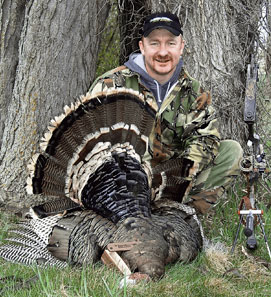
Double Bull co-owner Keith Beam backed up his turkey lessons with a Merriam longbeard. |
"Ok, I see him. Geez, he's got to be close to a quarter-mile away. I doubt he'll even hear my calling, but I'll give it a shot," I told Bob. I leaned close to the window and yelped and cutt on my diaphragm as loud as possible while Bob watched the bird through his binos. Bob could see the bird answer about two seconds before the sound actually reached our ears. I cutt hard and loud again. The bird gobbled, broke strut, and started in our direction.
To get to us he would have to cross two deep, wooded ravines. We lost sight of him in the first ravine, but the growing volume of his gobbles told us he was still on his way. All of a sudden he quit talking. Minutes passed without a sound, and I figured one of two things had happened -- either his talkative nature had attracted a hen and now he was with her, or he was closing the distance and didn't want to announce his presence.
I don't purr real well with a diaphragm, so I grabbed my glass call and let out a few soft purrs. His immediate response was so loud I dropped my call's striker in surprise. I peeked through a small hole in the blind, and there he was, 50 yards behind the blind and in full strut. The top of his bright red head glowed white, and the feathers on his ballooned-out chest took on a metallic shimmer with each turn into the sun. He was a thing of beauty!
The stuffed decoy was facing him, and I thought for sure he was going to hold his ground, expecting "her" to come to him. Luckily, our blind blocked his vision and he began a slow, proud dance toward us, his well-worn wingtips rustling the prairie grass -- and my nerves -- with every strutting step.
He passed within feet of the blind, and I swear I could feel the vibration when he spit and drummed. Bob could see him from where he sat in the blind and gestured that I could shoot at anytime. I knew we could get some great footage of the tom strutting less than 10 yards from the blind, but I was coming unglued and knew the sooner I shot the better.
As the gobbler appeared in front of the blind I came to full draw. Take it easy...don't blow this, I thought as I placed my pin ahead of the bird. The tom strutted right up to the decoy, and when my pin met his wingbutt I released. My arrow hit with a dull thump, sending the bird into a series of gyrations (13 to be exact) that took him around the back of the blind and down over the hill.
I ran to the top of the ravine, expecting to find my bird, and was shocked when he was nowhere in sight. Luckily, a trail of blood and feathers led me 100 yards down the ravine where he lay dead near a creek. He was a mature bird with an eight-inch beard and beautiful white bands -- indicative of Merriam's turkeys -- on his full fan.
Bob had been taping the recovery, and when I was finished admiring the tom he turned off his camera, extended his hand, and said "You did it, buddy. Great shot!"
After years of trying, it felt wonderful to finally have that big monkey off my back. I wasn't alone in my success, either. Later that day, Mike Carney arrowed a beautiful tom of his own, as did Keith Beam. Brooks filled his second tag the next day, making another perfect shot with his longbow. Five mature birds by four bowhunters in three days might sound impressive, but trust me, it's just par for the course when your hunting with the Gobbler Guru of Gregory.
Continued -- click on page link below.
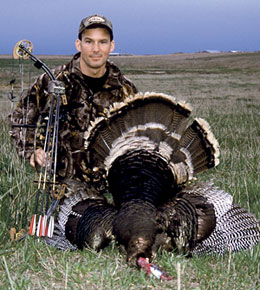
VP, Group Publisher Mike Carney applied our hosts' lessons, which paid off in the form of a beautiful tom. |
KEYS TO SUCCESS
I learned a lot about bowhunting turkeys from Dave, Keith, and Brooks. Following are a few of their tips that are guaranteed to improve your odds this spring.
Blinds. Use them. They hide your movements and make it easier to draw on a bird. Don't skimp when buying a blind. A quality blind is one that doesn't flap in the wind, is quiet, has a dark interior, and allows you to see and shoot in almost every direction.
Setup. Turkeys aren't bothered by ground blinds, so don't be afraid to set one up in the middle of an open field. The most important thing in setting up is location. You just need to be where the birds want to go. This is where year-round scouting really pays off.
Decoys. The stuffed hen decoys we used were as realistic as they come, and I highly recommend them, provided they are legal for use where you're hunting. Keith and Brooks believe there's no such thing as too close when setting up decoys, and they place theirs 7-11 yards away, facing the blind. "A strutting tom will always circle the decoy to face her head-on, and when he does he'll present an in-your-lap shot," Brooks said.
Shot Placement. A turkey's vitals are about the size of your fist, so shot placement is critical. According to Brooks, you can't hit a turkey too high, and the best shots are those taken when the bird is broadside or facing away. On a broadside bird, aim along the line between the top of the wing and where the 12-ring on a McKenzie turkey target is located and you'll hit either vitals or spine. Shooting a bird facing away from you usually results in your arrow hitting the spine, which will put the bird down quickly.
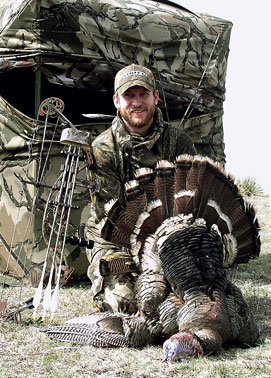
I applied our hosts' lessons, which paid off in the form of my first bird with the bow. |
Author's Notes: On this hunt I used a Hoyt Xtec set at 65 pounds, Easton C2 340 carbon shafts, 100-grain Rocky Mountain Assassin broadheads, Montana Black Gold Dusk Devil sight, Trophy Taker Shakey Hunter rest, Whitewater clothing in Realtree Hardwoods camo, Nikon Monarch ATB 8x42 binos and Monarch Laser 800 rangefinder, a Double Bull Matrix blind, and calls from Cody Turkey Calls.
Mike Carney used a Hoyt CyberTec bow, Gold Tip arrows, Rocky Mountain Snyper XP3 broadheads, ScentBlocker ProTec XT jacket, Whitewater fleece pants, and Nikon optics.
Dave Keiser is a fun guy to be around, and he definitely knows what it takes to harvest turkeys with bow and arrow. In 2005, 60 of his clients arrowed 75 birds. Besides turkeys, Dave also offers antelope and mule deer bowhunts and gun/bowhunts for pheasant. For more information, contact: Dave Keiser, Double K Guide Service, 211 Von Seggern St., Gregory, SD 57533; (605) 835-8658; dave@doublekguides.com or dtkeis
er@gwtc.net; www.doublekguides.com.
Continued -- click on page link below.
| Equipment Notes: Turkey Blinds |
By Brian Fortenbaugh, Assistant Editor
1) Ameristep's Intimidator is a new hub-style blind measuring 60" square by 67" tall. Its new NS3 MICRO-TECH fabric's dull fleece finish is quiet and won't shine in the sun, and its adjustable camo-mesh window system gives you 360-degree visibility. Other features include a noise-free magnetic window curtain, electronic game call speaker window, a ground skirt to keep scent in, three camera ports, a shelf for keeping gear close, and eight replaceable mesh window sections (Ameristep, 810-686-4035, www.ameristep.com).
2) The SurroundSight window system in Double Bull's Matrix 360 blind gives you 5,520 square inches of visibility so you can see and shoot in every direction. Its Silent Slide system lets you open as many sides of the blind as you want -- up to 23 inches -- in seconds. Other features include a center height of 6'7"; a 76" shooting diameter; 5'x5' floor space; four additional shooting ports; drop-down, shoot-through netting; blackened interior; and four tie-downs. Weight is 20 pounds (Double Bull Blinds, 1-888-464-0409, www.doublebullarchery.com).
3) Eastman Outfitters' Carbon Venture Magnum blind's dark interior, Black Silhouette Blocker, and EXSCENT Carbon-Activated Scent Elimination combine to make you virtually undetectable to your quarry. It measures 71" square so there's room for two people plus gear, and its 78" height allows for standing bowshots. Other features include Silent Magnet Window System, camera ports, 220-denier polyester shell, and a backpack-style carrying bag. It's available with or without the concealing Safari System (Eastman Outfitters, 810-733-6360, www.eastmanoutfitters.com).
4) Hunter's Specialties' 10-10 Hideout Blind measures 6'3" tall and 7' wide at the base and sets up fast. Its shell is made of water-resistant nylon and its features include four zippered, see-through mesh windows; window covers for further concealment; darkened interior; wheelchair access; stakes for windy days; and a carrying case with shoulder straps. Weight is 13.42 pounds (Hunter's Specialties, 319-395-0321, www.hunterspec.com).
5) Invisiblind's 6-Second Magnum offers four-sided shooting and its front panel alone has over 8 square feet of shoot-through material. Measuring 6 1/2' H x 6 1/2' L x 5' W, it's constructed of water-resistant polyester and has a blackened interior that keeps game from seeing your movements until it's too late. Setup time is six seconds. Large enough for two adults plus their gear, the blind is also wheelchair accessible (Invisiblind is no longer in business.)<!--, 1-800-247-6788, www.invisiblind.com).-->
6) Underbrush's Bowhunter blind sets up quickly and provides room for one hunter plus gear. It measures 5' high in the center with a 5'x6' floor and a weight of just 5 pounds. It features a dark interior and Slide-Drape Windows on all four sides for better viewing and limitless shot angles (Underbrush/Shelter-Pro, LLC, 1-888-376-2004, www.underbrushblinds.com).
7) Yukon Tracks' Dispatcher is a hub-style blind that measures 60" square by 70" tall and weighs 14 pounds. It's made of durable Oxford/poly material with the exclusive Rivers Edge camo printed on it. Features include a darkened interior; extra-large, shoot-thru mesh covered windows; tie-down ropes; ground stakes; and a backpack carrying case (Yukon Tracks/Div. of Ardisam, Inc., 1-800-345-6007, www.ardisam.com).
|
|
